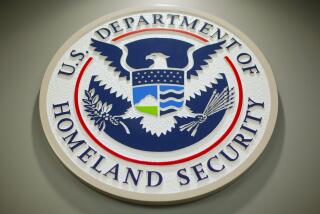U.S. expands refugee program for Central American families
Reporting from WASHINGTON — The Obama administration announced an expansion Tuesday of a program that allows minors from three violence-plagued countries in Central America, and now some of their relatives, to apply for refugee status.
The move is intended to bring refugee families together, officials said. But it could prove another partisan lightning rod in the debate over immigration in the U.S. presidential campaign.
The rule changes appear more modest than some of President Obama’s controversial efforts since 2013 to expand immigration opportunities.
Obama’s attempt to broaden the Deferred Action for Childhood Arrivals program to include parents of children brought to the country illegally was shut down in 2015 by a federal judge in Texas. The U.S. Supreme Court let that ruling stand in a 4-4 tie last month.
The latest push could help thousands of people in El Salvador, Honduras and Guatemala — countries battling gang violence, political killings and severe poverty — to enter and legally stay in the United States.
Under a 2-year-old program, children and youths under 21 from those nations can seek asylum if they have a parent who is here legally.
The applicants are interviewed and vetted in their home countries in an effort to prevent them from making the perilous journey north across Mexico, a route chosen by tens of thousands of minors and families in recent years.
Under the expansion announced Tuesday, older relatives of those children, including “caregivers,” can also apply for refugee status.
In a telephone briefing for reporters, U.S. officials acknowledged that the program is struggling with a backlog of applicants.
About 9,500 minors have applied for U.S. refugee status in recent months from the three countries, said Alejandro Mayorkas, deputy secretary of Homeland Security.
He says 2,884 applications have been approved, but only a few hundred applicants have entered the United States.
Mayorkas says he anticipates substantially more people will apply under the expanded program.
“The volume could be significant,” he said. “The overarching goal here is family unification.”
Until now, the parent legally in the U.S. could apply for refugee status only for an unmarried minor younger than 21. The expanded program will allow that child’s older siblings, his or her other parent or his or her caregivers, including aunts, uncles and grandparents, to also apply.
“This is recognition that families aren’t the traditional mom, dad, kids, especially in dangerous countries where [traditional families] can get disrupted, or in regions where a lot of parents have migrated to the U.S.,” said Faye Hipsman, associate policy analyst with the nonpartisan Migration Policy Institute and author of a report on the program.
But Hipsman said the number of people who will benefit from the new rules will be limited because of the requirement that a parent or relative already live in the U.S. legally.
“So while more people will certainly benefit, it will likely be on the margins,” said Hipsman, the California program coordinator for the institute.
Some critics saw cynical motives behind the new rules, saying they were timed to coincide with the start of the fall presidential campaign.
“The president is trying to make a political impression,” said Jan Ting, a law professor at Temple University Beasley School of Law in Philadelphia. “It can be construed as a trick to get people to stay in their home country at least for the next few months until after the election.”
See the most-read stories in National News this hour >>
Ting said in a telephone interview he believed the Obama administration was concerned about the political fallout from another surge of migrants, including thousands of unaccompanied children, crossing the Southwest border before the November election.
“They are trying to send a message to Central Americans: ‘Hey, don’t come. At least don’t come in the next 90 days and we will make it easier for you to apply,’” said Ting, a board member at the Center for Immigration Studies, a think tank in Washington that advocates reducing legal immigration flows.
The expanded program sets up a temporary transit shelter in Costa Rica, which agreed to periodically take 200 refugee applicants while they await processing.
Mexico also agreed to accept more asylum seekers after Obama met with Mexican President Enrique Peña Nieto at the White House last week, Mayorkas said.
Between 2013 and 2014, the number of Central American children caught attempting to cross the U.S. border jumped by 149% to 151,705.
The flow then subsided somewhat, but began to grow again late last year.
“By themselves, today’s actions will not solve this challenge,” Anne Richard, assistant secretary of State for population, refugees and migration, told reporters on the call. “But they are steps in the right direction.”
MORE NATIONAL NEWS
What’s at stake in the Democratic and Republican family feuds
ADHD is now classified as a specific disability under federal civil rights law
Michelle Obama’s stunning convention speech: ‘When they go low, we go high’
More to Read
Sign up for Essential California
The most important California stories and recommendations in your inbox every morning.
You may occasionally receive promotional content from the Los Angeles Times.












